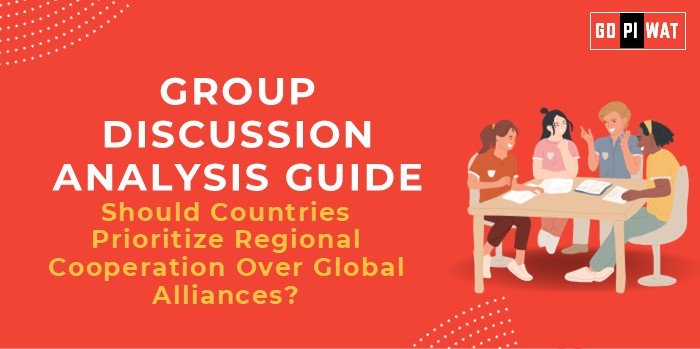📋 Group Discussion Analysis Guide: Should Countries Prioritize Regional Cooperation Over Global Alliances?
🌐 Introduction to the Topic
- Opening Context: In a world interconnected by trade, diplomacy, and technology, the debate over whether regional cooperation should take precedence over global alliances is pivotal. Regional frameworks like ASEAN or the EU highlight localized strength, while global platforms such as the UN or WTO champion a broader collective effort.
- Topic Background: The concept of regional cooperation traces back to efforts like the Marshall Plan post-World War II, aimed at fostering regional unity to rebuild economies. Today, with shifting geopolitics and globalization dynamics, nations are reevaluating the benefits of regional focus over global partnerships.
📊 Quick Facts and Key Statistics
🌍 ASEAN Trade Value: $3.6 trillion (2023) – showcases the power of regional cooperation in driving economic growth.
💰 NATO’s Budget: $1.2 trillion (2024) – reflects the scale of global alliances’ defense commitments.
🌐 Global Trade Dependency: 52% of world trade occurs within regional trade blocs – highlights regional cooperation’s dominance.
📊 BRICS GDP Share: 31.5% of global GDP (2023) – underlines the growing influence of regional alliances.
💰 NATO’s Budget: $1.2 trillion (2024) – reflects the scale of global alliances’ defense commitments.
🌐 Global Trade Dependency: 52% of world trade occurs within regional trade blocs – highlights regional cooperation’s dominance.
📊 BRICS GDP Share: 31.5% of global GDP (2023) – underlines the growing influence of regional alliances.
👥 Stakeholders and Their Roles
- 🏛️ Governments: Shape policies to strengthen regional or global ties.
- 🌐 Regional Organizations (e.g., EU, ASEAN): Facilitate trade, security, and diplomacy within regions.
- 🌍 Global Institutions (e.g., UN, WTO): Coordinate international policies and conflict resolution.
- 🏢 Private Sector: Operates across regions or globally, influenced by trade agreements and regulations.
- 👥 Citizens: Impacted by economic opportunities, security, and cultural exchanges.
🏆 Achievements and Challenges
✨ Achievements
- 🌍 Regional Cooperation:
- EU: Achieved seamless intra-regional trade through the Schengen Area and the Euro.
- African Union: Launched the African Continental Free Trade Area (AfCFTA), boosting regional trade by 25%.
- 🌐 Global Alliances:
- Paris Agreement: A landmark global accord on climate change with 196 signatories.
- WHO: Coordinated global responses during the COVID-19 pandemic.
⚠️ Challenges
- 📉 Regional Cooperation: Risk of regionalism leading to fragmentation (e.g., Brexit’s impact on EU cohesion).
- 💼 Global Alliances: Ineffectiveness due to bureaucracy (e.g., UN Security Council deadlocks on conflicts like Syria).
🌍 Global Comparisons:
- ✅ Regional Success: The EU’s single market model versus limited regional cohesion in South Asia.
- ❌ Global Failures: Slow WTO negotiations compared to faster bilateral or regional trade deals like RCEP.
📚 Case Studies:
- 🌐 Regional: ASEAN’s cooperation during the RCEP negotiations.
- 🌍 Global: UN’s delayed response to the Rohingya refugee crisis.
📢 Structured Arguments for Discussion
- ✅ Supporting Stance: “Regional cooperation allows for tailored policies addressing localized needs, ensuring effective resource allocation and stronger cultural ties.”
- ❌ Opposing Stance: “Global alliances are essential to address challenges like climate change and pandemics, which transcend regional boundaries.”
- ⚖️ Balanced Perspective: “A hybrid approach that strengthens regional cooperation while ensuring alignment with global goals is optimal.”
🧠 Effective Discussion Approaches
- 🎯 Opening Approaches:
- Start with a statistic: “52% of global trade occurs within regional blocs…”
- Raise a question: “Can regional focus truly replace the global framework in addressing worldwide crises?”
- 🤝 Counter-Argument Handling:
- For Regional Cooperation: Highlight successes like AfCFTA while addressing concerns like inequality.
- For Global Alliances: Present examples like the Paris Agreement but acknowledge bureaucratic delays.
📊 Strategic Analysis of Strengths and Weaknesses
- Strengths: Localized focus, cultural affinity, quicker decision-making.
- Weaknesses: Fragmentation risks, limited scope for addressing global crises.
- Opportunities: Build regional resilience, leverage complementary economies.
- Threats: Global isolationism, weaker voice on global platforms.
🎓 Connecting with B-School Applications
- 💼 Real-World Applications: Frameworks for analyzing international trade, policy, and diplomacy in business strategy.
- 📚 Sample Interview Questions:
- “What role do regional organizations play in mitigating economic downturns?”
- “How can businesses benefit from regional trade agreements?”
- 💡 Insights for B-School Students: Study cross-regional business models, analyze the trade-offs between local focus and global reach for firms.


